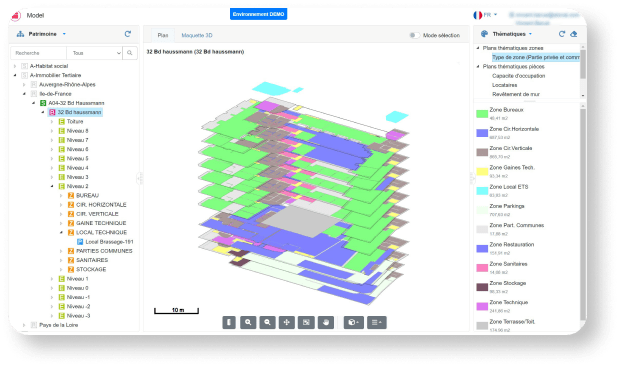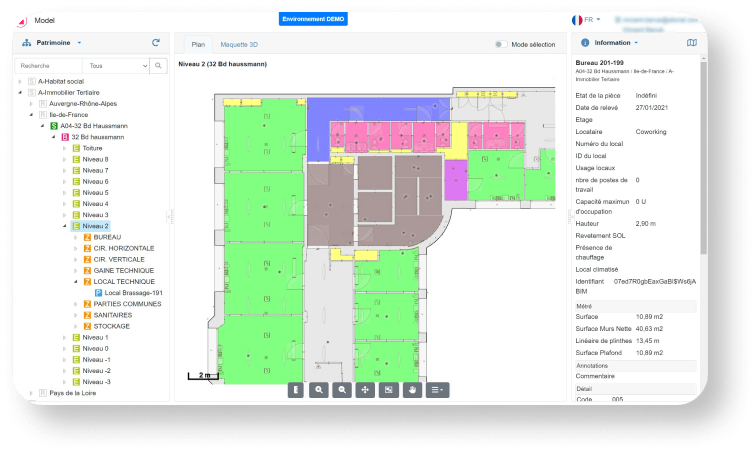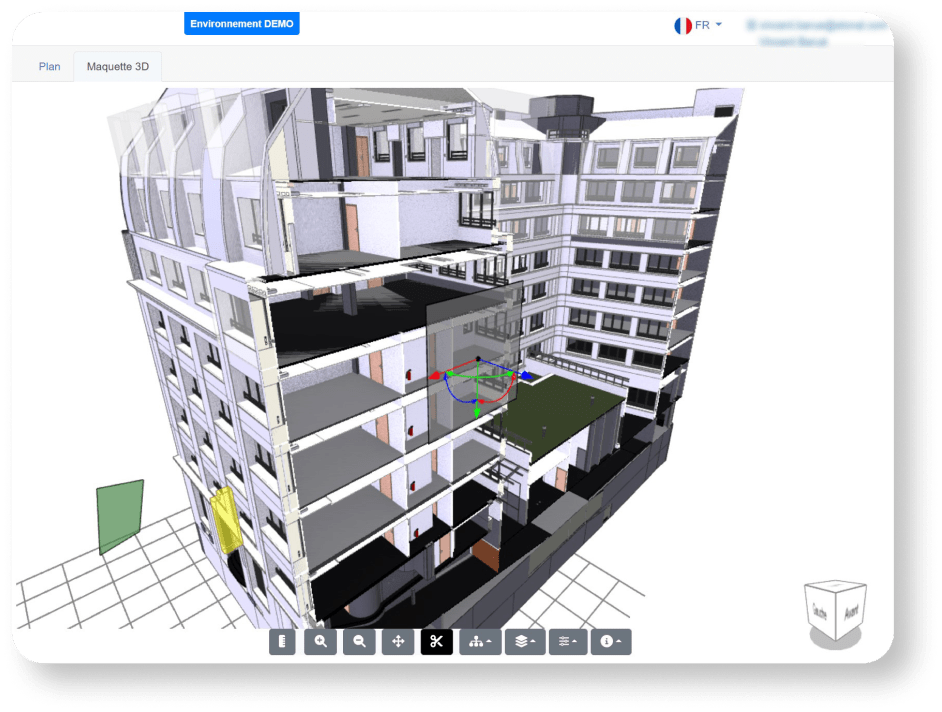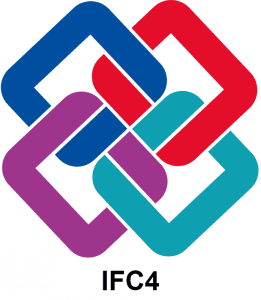The need to have a complete and spatial description of portfolios becomes the foundation of the strategy of value-creation in real estate management.
Digitizing buildings in BIM language (Building Information Modelling) makes it possible to quickly take inventory in the form of a precise and structured database ready for management – operation – maintenance. Components, equipment, spaces are spatialized within a digital model of the building, its avatar.
Stonal is able to manage all the components and equipment in a building thanks to its meta library. This tool enables all the building’s components to be organised and structured, and facilitates the management and development of the attributes needed to track these digital building objects. The meta-library is connected to the catalogues of component manufacturers and suppliers, and includes all their characteristics, both technical and geometric, with the ability to update them automatically. It incorporates information such as the life cycle of these components, as well as their carbon weight, enabling the decarbonisation of buildings.
With the implementation of digitized building information. It is possible to:


Create queries (number of components or equipments, type of space, height, etc.)
Link documents with graphic information
Geolocated information to easily update and share them
More effectively share asset’s knowledge and their architectural, technical, functional and rental structure
Data transversal view
The platform allows the same data to be viewed in different graphical or non-graphical forms. Several degrees of plan digitalisation can co-exist for a transversal vision of the data:
Alphanumeric repository
2D dynamic
plans
3D BIM
models

Stonal’s platform is fully compatible with BIM construction formats. BIM (Building Information Modelling) models are saved into the database to preserve guarantees.
Then, the digital model is transformed for management - operation - maintenance (BIM GEM), and becomes an integral part of the real estate database.
The real estate BIM methodology requires greater interoperability between product and building databases in order to unify and make reliable the exchange of information at all scales.
A real-estate meta library is a database of BIM objects shared by all project stakeholders, with 3D assets associated with manufacturer data that can be integrated into all projects. A meta library makes it possible to manage, share and update property asset objects and data on the fly, in any design software. It thus plays a direct part in the digital continuity between all the life phases of a real estate project.
Stonal is deploying its meta library in order to industrialise the data collection and reliability processes for both new and existing projects. Its implementation is part of the interoperability and reversibility of customer data managed by Stonal.
This tool enables all building components to be organised and structured and facilitates the management and development of the attributes needed to monitor these digital building objects. The meta-library is connected to the catalogues of component manufacturers and suppliers and integrates all their characteristics.
The meta library makes it possible to manage, share and update building asset objects and data on the fly, in any design software. In this way, it contributes directly to the digital continuity between all the phases in the life of a property project.
By transforming a building into a database, the BIM methodology enables us to work together to centralise and harmonise all the information about an asset. Enhanced technical descriptions ensure that all information is managed rationally and consistently.
In the project and construction phases, BIM and digital mock-ups make it easier to visualise and anticipate a project and its progress, and to identify errors and potential problems before construction begins.
In the operational phase, the digitisation of buildings in real estate BIM language enables them to be rapidly inventoried in the form of a precise and structured database.
BIM has a major impact on optimising construction and operating costs, as well as on the productivity of companies across all life cycles, because all employees “consume” asset data that is easy to use, unique, shared and reliable in terms of usage.
Building Information Modeling (BIM) is a data management method that enables 3D models of a building or infrastructure to be created, viewed and shared. It is a collaborative design method based on a single model known as a digital mock-up.
A digital mock-up, on the other hand, is modeled in what is known as an “object” language, since sites, buildings, components, spaces, equipment, components and sometimes even operating elements are modeled in the form of families of 3D objects to which dimensioning, object type, performance, manufacturer characteristics are attached.
Architects, engineers and then operators and maintainers enrich the same digital model, which becomes a veritable three-dimensional database for each project. BIM has an impact on all phases of building construction and operation, and its adoption rate worldwide keeps on growing.
Stonal was one of the pioneers in the deployment of BIM in management – operation – maintenance processes thanks to its subsidiary Foundation, which has over ten years’ experience on hundreds of projects. At Stonal, BIM takes on an extra dimension because, when combined with data and documents, it makes it possible to spatialise all the information about a building, a portfolio or a fleet, so as to manage it more effectively and optimise its carbon footprint throughout its lifecycle.
Digital continuity or handover between all these players at each phase of the project has become crucial throughout the lifecycle. Particularly between construction and operation, where the players do not have the same information needs or the same interfaces.
To make management – operation – maintenance more reliable over the long term, Stonal offers its customers the option of digitising their existing assets in the form of digital mock-ups and is an expert in the integration of digital construction mock-ups.

Stonal's platform is IFC compatible.
Stonal complies with the ISO 16739 standard
28 cours Albert 1er, 75008 Paris
17 rue Sainte Catherine, 31400 Toulouse
91 Wimpole Street, Marylebone London, W1G 0EF
© Stonal // 2022 // All rights reserved